Dec 12, 2025
Dec 12, 2025
Animal Love and Symbolism
Continued from Part LIX
While reviewing many lost ancient civilizations in the various parts of the world, it is observed that many of them were, although, highly evolved but had largely focused and prospered on materialism as against the Sanatana Dharma of the erstwhile Bharatvarsha (India), where the focus remained on spiritualism evolved as an ingrained philosophy of life, with the ancient scriptures and sages constantly teaching its value and significance in self-progression and enlightenment, and the futility of material pleasure and comfort of a germane life in the long run. Some of the most ethical concepts with universal appeal such as Ahimsa Paramo Dharmah (non-violence is ultimate righteous duty), Vasudhaiva Kutumbakam (whole world is one family) and Sarva Dharma Sambhavah (all faiths lead to the same destination) are the priceless gifts of ancient Hindu civilization to the humanity.
These teachings of the Vedas and Upanishads were not merely applicable and limited to the human beings but were spread for the welfare, protection and preservation of all living beings including animals and birds. Perhaps this is also an obvious reason why a large number of Hindus still remain vegetarian, and love to protect and feed other lives, more particularly ones like domesticated cattle including cow, and other pets like horse and dog, which have been traditionally useful to mankind in various ways. As against this culture and tradition, other civilizations remained material centric and consumption oriented; then, the later evolved Abrahamic religions further consolidated on this tendency, and even put forth the concept that the God or Allah has created all other living and non-living things for the consumption of the faithful (follower of the particular faith/religion).
Significance of Animals in Hinduism
Due to the scriptural edict and prevailing ancient culture, animals and birds have occupied a significant position in Hinduism. The ingrained philosophy and concepts of Brahman (God) and Self (soul) is not restricted to the human beings alone but is equally applicable to all living being in the universe. All living things including human beings and animals possess souls comprised of same ethereal element but the difference remains in their physical and spiritual evolution and progression. Consequently, unlike humans, the elements like senses, mind, ego and intellect do not fully evolve and manifest among animals, and/or their evolution is reflected in varying degrees leading to a limited and restricted sense of speech, intelligence, knowledge and other skills.
In essence, every living being, be it human or animal, have a soul which cannot be treated as inferior or subordinate. Instead, it is Karma-based birth-death-rebirth cycle that dictates the state of evolution and opportunities of liberation. The Hindu Puranas, Epics, folklore and legendary tales narrate several instances or stories where an auspicious soul purportedly entered or resided an animal body by birth or some celestial event to serve a specific reason or fulfil certain cause. Even in the practical life too, we observe how animals and birds are able to develop certain human like instinct, skills and attributes when they are properly tamed and trained. These experiences only strengthen the concept that all living beings/souls are only manifestations of Supreme Soul (Brahman), and, therefore, everyone should be treated fairly and allowed to evolve in their natural ways.
According to Hindu spiritual belief, irrespective of the body occupied at a given time, a soul essentially has the same nature and attributes, and, therefore depending upon the living body occupied, if affects only its probability of liberation due to factors like the sensory capability, mind and intellect. Ancient Hindu laws and codes also prescribe how animals shall be treated by the human beings, and love and compassion to animals is also one of the virtue of people pursuing the righteous path in the pursuit of liberation. According to scriptures, the cruelty or killing of animals carries similar karmic consequences as that of the similar acts with other human beings. For instances, some Shastras and Puranas provide same consequence and punishment for Gau-hatya (killing a cow) to that of Brahm-hatya (killing a Brahmin). Even in modern times, whiles majority of the other communities in the world indiscriminately consume a wide range of animals for food and other reasons, the meat-eating Hindus are very discreet and settle for only a few identified animals.
The main difference at the spiritual level between the human beings and animals remain the relative weakness or absence of the higher mind capability and intellect (Buddhi) in the latter that enables a soul making right choices, and, therefore, they are instinctively driven by the nature (gunas). According to Hindu belief, every animal bears a specific cosmic feature or mystery that makes it auspicious for humans to learn and recognize its spiritual significance. Some ancient Hindus even believed that the animals might carry souls of their ancestors that may be reborn in lower yoni (abode) even as family members. In ancient India, the Pasu Vidya (knowledge of animals) was considered as an important discipline with a lot of symbolism attached to them.
Hinduism also recognises and accepts the significance of animals in the transmigration of souls. Several animal seals were recovered from the excavations made at the archaeological sites such as Harappa, Mohenjo-daro, Dholavira, Ganeriwala and Rakhigarhi as part of the Indus Valley Civilization, which even scientifically indicates the importance of animals to the human beings in ancient India. Some of the animals and birds like the elephant, horse, cow, bull, tiger, lion, boar, deer, antelope, gazelle, monkey, dog, Garuda and owl, etc., are considered auspicious and spiritually more evolved. Accordingly, many of them have enjoyed an exalted status in Hinduism and are symbolically honoured or worshipped as vehicles of gods.
Since Vedic age, Hindu sages and seers had established their Ashram (abode) in remote locations in jungles and predominantly lived there in complete harmony with the nature and wild life. Apart from their knowledge and spiritual accomplishments, they are also known for their compassion, love and care of the animals. Many of these animals find a venerable mention and place in the Puranic tales, two greatest and all-time epics of Ramayana and Mahabharata, folklore and legendary stories. Some of these animals, the rationale of their symbolism, and their associated value and importance in Hinduism is briefly discussed in the following paragraphs.
Animal Symbolism
Animals being used as Vahanas or vehicle of deities indeed suggest a deeper symbolism in Hinduism. Sometimes, they simply indicate the situational magnimity and grace. For instance, an elephant is the biggest and powerful land animal while god Indra was the king of devas, so the elephant serves as the vehicle of Indra. Similarly, Vayu is the god of air and speed, so the horse serves as his vehicle. In the case of Trimurti representing creation, sustenance, the chosen vehicle denotes the cosmic elements over which gods have control. For example, the creator god Brahma is also considered the lord of the primordial water element that symbolizes the consciousness too. Brahma is the master of mind and responsible for the knowledge and wisdom. Hence the water bird Hamsa (Swan) that can efficiently sail through water with ability to segregate impurities from it, serves as the vehicle of Brahma, and the goddess of knowledge, Saraswati.
The sustainer god Vishnu represents the element Akasa (space or sky), the mid region filled with sunrays. As the lord of sky, his own colour is depicted as blue or dark, which is also the commensurate colour of the sky during the day and night. Due to abundance of solar rays in space, Vishnu is also considered as a solar deity having chosen Garuda (an eagle) as vehicle suitable for movement across the sky. On the other hand, the god of destruction Shiva represents earth with his abode at the Mount Kailash in high Himalayas. He nourishes the earth by making it fertile and liveable for the living beings and is also considered as the lord of animals (Pasupati). Accordingly, the Nandi (Bull) is chosen as his vehicle.
The goddess Shakti (Durga) represents primordial cosmic energy and dynamic force with great ability, strength and power. In addition, she also represents control over the destructive powers and emotions as shown by the wild animals like lions, tigers, and so on. Therefore, the ferocious and magnificent lion and tiger are chosen as her vehicle. Kartikeya, elder son of Shiva, represents pride and vanity riding on peacock, Ganesha on mouse (greed) and Agni on goat (impurity). As it appears, the animal vehicles represent symbolism to certain elements and energies of nature and the respective deities exercise the control and lordship over them. To put it in another way, the vehicles in animal forms represent the vastness, attributes and positive/negative energies of the nature, while the respective gods represent the control and mastery over them. Few important animals with some divinity attached are briefly discussed here:
1. Elephant (Airavata):
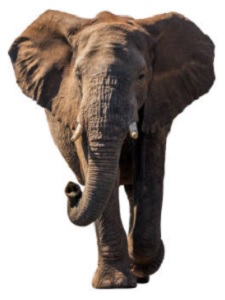 In the animal kingdom, an elephant is not only the largest animal but also the symbol of royalty, strength, intelligence and keenness apart from its vast grasping and destructive potential. Among the animals, the elephants are very close to humans and their intellect is said to be highly evolved. Since ancient ages, the human beings in India have been so influenced and fascinated by the attributes like royalty, strength and power that even dynasties have been named after the elephants. For instance, the Gajapatis (lords of the elephants) was a medieval Hindu dynasty that originated in the Odradesha (most of present-day Odisha and Northern coastal Andhra) from 1434 to 1541 CE. The dynasty was established by the King Kapilendra Deva in 1434 CE and it became an empire stretching from the lower Ganga in the north to the Kaveri in the south. In the ancient warfare, the trained elephants played an important role in offensive as well as defensive operations.
In the animal kingdom, an elephant is not only the largest animal but also the symbol of royalty, strength, intelligence and keenness apart from its vast grasping and destructive potential. Among the animals, the elephants are very close to humans and their intellect is said to be highly evolved. Since ancient ages, the human beings in India have been so influenced and fascinated by the attributes like royalty, strength and power that even dynasties have been named after the elephants. For instance, the Gajapatis (lords of the elephants) was a medieval Hindu dynasty that originated in the Odradesha (most of present-day Odisha and Northern coastal Andhra) from 1434 to 1541 CE. The dynasty was established by the King Kapilendra Deva in 1434 CE and it became an empire stretching from the lower Ganga in the north to the Kaveri in the south. In the ancient warfare, the trained elephants played an important role in offensive as well as defensive operations.
The elephants were native to India and existed in the Indian subcontinent ever since the Vedic civilization. The divine elephant Airavata finds a mention in Puranas as the vehicle of the devas King Indra, which was a white elephant emerged during the churning of the oceans by devas and asuras. Other puranic names of this legendary elephants are 'abhra-Matanga' (elephant of the clouds), 'Naga-malla' (the fighting elephant) and 'Arkasodara' (brother of the sun). Many legendary tales and descriptions are also associated with Airavata, which inter alia include his wife’s name as Abhramu and that he had ten tusks and five trunks with a spotless white skin. Another auspicious god Ganesha is depicted as having the head of an elephant, which is symbolic to the wisdom, knowledge and power of contemplation. Also, the elephant trunk symbolizes the grasping power and large ears suggest the attentiveness.
2. Garuda (Eagle):
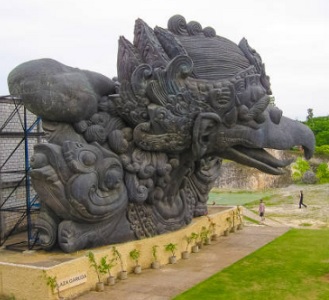 Garuda is somewhat an eagle-like legendary sun bird described in many Hindu Puranas, Epics Ramayana and Mahabharata, folklore and legendary tales. In fact, one of the eighteen Mahapuranas are named after him as Garuda Purana. In all such accounts, he is depicted as the Vahana (vehicle) of god Vishnu. In fact, a celestial deva is described as Garutman with wings even in the Rigveda and the Shatapatha Brahmana embedded into the Yajurveda, and some scholars have suggested him to be same Garuda due to many analogous characteristics. In many versions, he is depicted as part-human with an eagle-like nose/beak, strong legs, open and big eyes, with the emerald body shade and slightly open golden-yellow wings. Also, Garuda has power to shape-shift according to needs and fast enough to reach anywhere within minimum time as personification of courage and valour. Usually, he is shown carrying Vishnu or depicted with a jar of Amrita (nectar of immortality), in solitary state.
Garuda is somewhat an eagle-like legendary sun bird described in many Hindu Puranas, Epics Ramayana and Mahabharata, folklore and legendary tales. In fact, one of the eighteen Mahapuranas are named after him as Garuda Purana. In all such accounts, he is depicted as the Vahana (vehicle) of god Vishnu. In fact, a celestial deva is described as Garutman with wings even in the Rigveda and the Shatapatha Brahmana embedded into the Yajurveda, and some scholars have suggested him to be same Garuda due to many analogous characteristics. In many versions, he is depicted as part-human with an eagle-like nose/beak, strong legs, open and big eyes, with the emerald body shade and slightly open golden-yellow wings. Also, Garuda has power to shape-shift according to needs and fast enough to reach anywhere within minimum time as personification of courage and valour. Usually, he is shown carrying Vishnu or depicted with a jar of Amrita (nectar of immortality), in solitary state.
The relevance and importance of Garuda can be fathomed from the fact that one complete Mahapurana is dedicated to his name in the Vaishnava tradition, several chapters of which are structured as the dialogue between Vishnu and His bird-vehicle Garuda discussing cosmic knowledge, functions and inter-relationship of Trimurti – Brahma, Vishnu and Shiva. The remaining contents are a diverse collection of the cosmology, mythology, inter-relationship of gods, ethics, good versus evil, yogic practices, Hindu philosophies, Karma, reincarnation, ancestral rites and soteriology, rivers and geography, and so on. Garuda aka eagle is often described as the king of birds, a protector and ever watchful entity against the enemy depicted as the serpent. Due to his role as fighting injustice to destroy evil, he was often depicted as iconic symbol of king’s duty, insignia of royalty and Dharma in the ancient India.
3. Nandi (Bull):
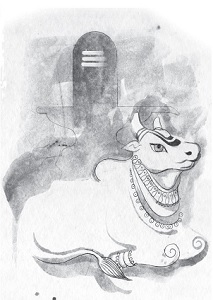 Nandi is depicted as the traditional gate-guardian of Kailash, the abode of Lord Shiva as well as his mount/vehicle as a bull. Although the word Nandi appears to have originally come from the Tamil root word Nandhu, suggesting the growth and flourishment. This makes sense as the South India, since ancient age, had a widespread culture of Shaivism, the followers of which are the devotees of Shiva. Traditionally, nearly all Shiva temple have stone images of white Nandi, big or small, in seated position usually facing the deity or main shrine. Many legendary tales are associated with Nandi and in such puranic and epical stories, he is depicted in both andromorphic and zoomorphic forms.
Nandi is depicted as the traditional gate-guardian of Kailash, the abode of Lord Shiva as well as his mount/vehicle as a bull. Although the word Nandi appears to have originally come from the Tamil root word Nandhu, suggesting the growth and flourishment. This makes sense as the South India, since ancient age, had a widespread culture of Shaivism, the followers of which are the devotees of Shiva. Traditionally, nearly all Shiva temple have stone images of white Nandi, big or small, in seated position usually facing the deity or main shrine. Many legendary tales are associated with Nandi and in such puranic and epical stories, he is depicted in both andromorphic and zoomorphic forms.
Bull is the male counterpart of the cow and traditionally the castrated bulls (oxen) have been used in India as the beast of burden since ancient times. India has been predominantly an agricultural country and nearly all families in villages reared castrated bulls for ploughing fields, harvesting and commuting or carrying luggage in bullock carts till the arrival of modern age fuel driven machines for the same purposes. As already indicated earlier, Shiva is treated as an earthly god and there could have been no better acknowledgement and patronage of so useful domestic animal as bull than symbolically associating it with Him. The archaeological evidence of Hindus worshipping Shiva and Nandi has been found even from the remnants of the Indus Valley Civilization with the recovery of Pasupati Seal depicting Shiva and Bull Seals at the Mohenjo daro and Harappa sites.
4. Hamsa (Swan):

The Hamsa (Swan), also known as Hansa, is an aquatic bird of passage, which is often used in Indian culture as an element of decor and spiritual symbol. In Puranas, Epics and folklore, it is depicted as the vehicle of god Brahma, and goddesses Saraswati and Gayatri. Arguably, Swan’s feathers do not get wet despite being in water; hence it is symbolized with the saintly person who lives in the world without getting attached with the Maya or Samsara. Swan’s white colour too symbolises the “Sattva” guna or purity. The swan is also sometimes symbolized with the Supreme Reality, Brahman, and its flight is linked with Moksha i.e., the release from the cycle of death and rebirth. Similarly, in the yogic exercises of breath control, Pranayama, the swan is epitomized with the prana (breath of life). The Vedic literature and later Puranas accorded a great spiritual significance to Hamsa and its various attributes, Even the Hindu saints having attained great spiritual power and learning are often referred to as Paramahamsa (Supreme Swan), yet another allegory attached to this divine bird.
5. Lion:
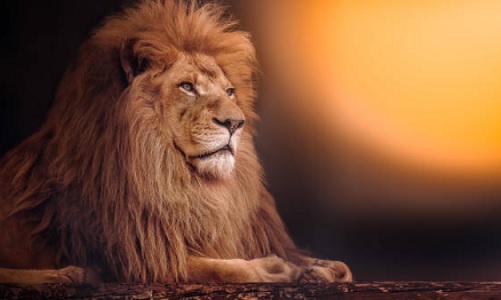
Unlike elephant which is wild but domesticated as well by man since time immemorial, the lions and tigers have remained in wild and are treated as symbols of royalty, strength, strategy, skill and ferocity not only in Hinduism but other civilizations as well world over. Of the two, the lion is treated more royal and majestic, which also features as the vehicle of goddess Shakti or Durga venerated in the most parts of the country but more specifically in Bengal, due to former’s inherent power and ferocity. Many legendary tales with the lion as central character in both andromorphic as well as zoomorphic forms are illustrated in Hindu Puranas, Epics and folk tales. Among them, the most important and popular being the Avatar (reincarnation) of Vishnu as Narasimha (man-lion) to kill the asura King Hiranyakashyapu and save his son Prahlad and humanity, who (Narsimha) is also worshipped as the Lion-god by many devout Hindus.
Narsimha is one of the ten incarnations of god Vishnu in probably the fiercest form, who is depicted with the head and shoulder of a lion and the torso of the man. Lions find mention even in the Hindu Vedas as well and they are also depicted in Hindu religious art and culture with all their royalty and ferocity. The face of the lion (singh-mukha) is often used in the sculpture and images in many Hindu temples on the walls, doors, arches, and windows. The memorial pillar at Sarnath erected by the Emperor Ashoka after his conversion to Buddhism, contains four beautifully carved standing lions at the top on a round abacus representing the imperial power, which now also constitute the official emblem of the government of India.
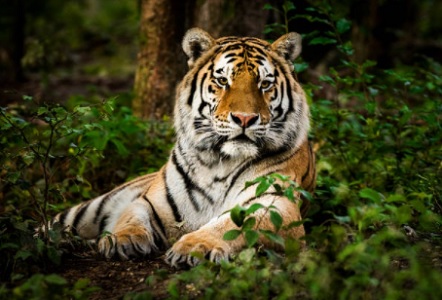
Along with the lion, the tiger with similar attributes is also given same place in Hinduism and is included as vehicle of Skandamata and Ambika Durga, which are different forms of goddess Shakti herself. Since ancient age, the Vedic surname Singh (Lion) was traditionally used by Kshatriya class (Rajputs), which was later also adopted by the followers of the Sikh pantheon.
6. Cow:
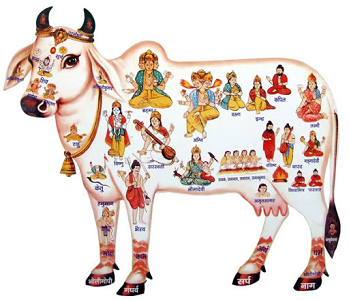 Kamadhenu is a legendary and divine bovine-goddess in Hinduism, commonly described as Gau Mata i.e., the mother of all cows. Several legendary tales are associated with her including that she emerged from the churning of oceans, and that she was a magical "cow of plenty" who provided whatever was wished from her. Consequently, the cow in Hinduism symbolizes sattvic gunas motherhood, motherliness, compassion, righteousness, purity, sacrifice, service and auspiciousness as also wealth and abundance. In Hinduism, the killing of cows for meat or any other purpose is prohibited and even formal laws to this effect are in place in many states. Since ancient time, killing of cow is treated as mortal sins and even equated with the killing of a Brahmin with severe karmic consequences.
Kamadhenu is a legendary and divine bovine-goddess in Hinduism, commonly described as Gau Mata i.e., the mother of all cows. Several legendary tales are associated with her including that she emerged from the churning of oceans, and that she was a magical "cow of plenty" who provided whatever was wished from her. Consequently, the cow in Hinduism symbolizes sattvic gunas motherhood, motherliness, compassion, righteousness, purity, sacrifice, service and auspiciousness as also wealth and abundance. In Hinduism, the killing of cows for meat or any other purpose is prohibited and even formal laws to this effect are in place in many states. Since ancient time, killing of cow is treated as mortal sins and even equated with the killing of a Brahmin with severe karmic consequences.
Apart from the religiosity attached, there have been socio-economic and scientific reason too why Hindus cared and reared cow and other cattle in India. The ancient Vedic society was agriculture based largely dependent on farming and cattle rearing. While the cow with her milk was a rich source of complete protein diet and medicines, the bulls were used in farming and transportation. Even the cattle dung was an easy and plenty source of fertilisers and fuel, and after death their skin and bones were used in making various articles and artefacts. The cow milk is also used in many cleansing rituals and worship of deities. Lord Krishna is known for his deep love and association with cows in childhood. Shiva is also known by the names of Gorakhnath and Pasupati; the former implies the lord of cows while the latter the lord of animals.
7. Buffalo:
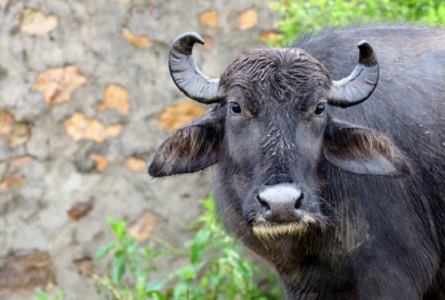
Buffaloes too fall in the category of cattle and traditionally the female buffalo is useful for milk while the male counterpart as the beast of burden in India for the ages. It has a dark mane, bulky and gross body suggestive of the tamasic guna, but represents both positive and negative attributes. The positive ones include divinity, strength and ferocity while the negative ones are the delusion, ignorance, lust and brute power. Consequently, it is linked with both divine and demonic entities in Hinduism. For instance, the water male buffalo serves as the vehicle of the Yama, who is the lord of the underworld (Naraka) and justice. On the other hand, Mahishasura was a buffalo demon, who for his many evil doings was slayed by goddess Durga. Buffalo seals recovered from the Indus Valley Civilization suggest the significance of this animal for man since ancient times.
8. Horse:
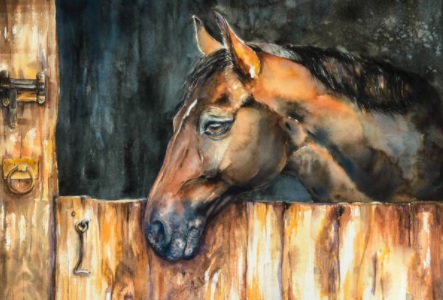
Since the Vedic world, or perhaps even before, the horse occupied a special place in the life of man as a companion, a vehicle and in the rituals. For illustration, they were domesticated and used in travel, sports, warfare, trade and even for the sacrifice in specified rituals. The horse, in the Vedic tradition, represented beauty, speed, freedom, grace and strength, and even symbolized the expansive power of Brahman. In Hindu mythology, Aditya (Sun) rides on a chariot with seven horses; also, horse is linked with the duo Asvin gods, who were associated with rescuing people lost in the wilderness or stuck up in an inaccessible location besides being master horsemen and physicians. As per legends, the churning of oceans also produced a divine white horse Uchchaihshravas, which was gifted to Indra and served as his vehicle. Yet another legend relates to a divine creature Hayagriva with the head of horse, which rescued Vedas during the devas conflict with asuras. Apart from Indra and Aditya, the horse is also linked to the Vedic deities Vayu, Rudras and Maruts.
9. Snake:
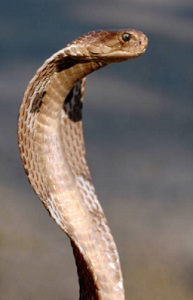 Since ancient age, the world at large has remained mystified with the position of snakes in India, which even today is the home some of the most poisonous snakes like Cobra, Krait and Vipers. Hence Hindus traditionally have a mixed feeling and attitude towards the snakes in as much as they are afraid and kill them but at the same time get fascinated and worship them too. The serpent symbolizes both the death and infinity (time and space without end) in Hinduism besides sexuality, fertility, weapons and Kundalini power. Hindu scriptures including Vedas, Puranas and Epics contain umpteen invocations, illustrations and tales of legendary snakes. In these illustrations and tales, they are often depicted as the celestial as well as subterraneous beings with own establishment and empire. Of the Trimurti, the god of sustenance Vishnu and the god of destruction Shiva are closely associated with snakes. While Vishnu is usually shown as resting on the coils of the primordial and infinite serpent Adi Sesha, Shiva is depicted as the lord of snakes usually with one poisonous snake invariably adorning his neck with raised hood. Snake worship is common in Hinduism even in the modern age in temples, homes and woods offering prayers, milk, incense and flowers often with the wish of conceiving a child.
Since ancient age, the world at large has remained mystified with the position of snakes in India, which even today is the home some of the most poisonous snakes like Cobra, Krait and Vipers. Hence Hindus traditionally have a mixed feeling and attitude towards the snakes in as much as they are afraid and kill them but at the same time get fascinated and worship them too. The serpent symbolizes both the death and infinity (time and space without end) in Hinduism besides sexuality, fertility, weapons and Kundalini power. Hindu scriptures including Vedas, Puranas and Epics contain umpteen invocations, illustrations and tales of legendary snakes. In these illustrations and tales, they are often depicted as the celestial as well as subterraneous beings with own establishment and empire. Of the Trimurti, the god of sustenance Vishnu and the god of destruction Shiva are closely associated with snakes. While Vishnu is usually shown as resting on the coils of the primordial and infinite serpent Adi Sesha, Shiva is depicted as the lord of snakes usually with one poisonous snake invariably adorning his neck with raised hood. Snake worship is common in Hinduism even in the modern age in temples, homes and woods offering prayers, milk, incense and flowers often with the wish of conceiving a child.
10. Dog:
 Perhaps after the horse, the dogs are other domesticated animals, which have been closely associated with the man possibly even from the pre-Vedic times. They do not enjoy the same exalted position as many other aforesaid animals but they have been very important to man as companion as faithful servants with varied duties. At some places, people believe that the dogs represent as guards of the doors of heaven and hell, and even symbolize it with the god of death Yama. In tantric traditions, a fierce form of Shiva is worshipped as Bhairava, who has a dog as his vehicle. Symbolically, dog represents the attributes of devotion, loyalty and obedience, and many legendary tales and practices can be found in various parts of India highlighting these attributes.
Perhaps after the horse, the dogs are other domesticated animals, which have been closely associated with the man possibly even from the pre-Vedic times. They do not enjoy the same exalted position as many other aforesaid animals but they have been very important to man as companion as faithful servants with varied duties. At some places, people believe that the dogs represent as guards of the doors of heaven and hell, and even symbolize it with the god of death Yama. In tantric traditions, a fierce form of Shiva is worshipped as Bhairava, who has a dog as his vehicle. Symbolically, dog represents the attributes of devotion, loyalty and obedience, and many legendary tales and practices can be found in various parts of India highlighting these attributes.
11. Monkey:
Monkeys do not have much relevance from the ritual or spiritual perspectives in Hinduism either in Vedic or post-Vedic period. However, due to their association as monkey-men with Sri Ramchandra and assistance rendered to him during the Lankan expedition, monkeys too are duly considered and even revered by many Hindus. In the Ramayana, they had played a crucial role in helping Rama to search his abducted queen, Sita, and finally rescue her from the demon Ravana’s captivity after a fierce legendary war. Besides, due to their superior learning abilities and antics, monkeys have been traditionally tamed and engaged by man for the recreational activities.
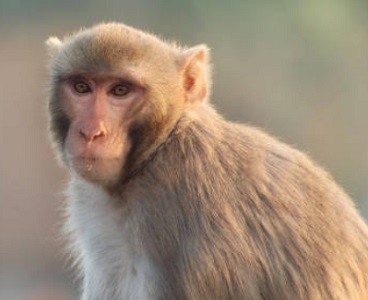 Monkeys are depicted with both positive and negative qualities. Symbolically, the positive attributes include divinity, righteousness, courage, obedience and loyalty, while the negative ones are the lack of discipline, focus, fickleness and mischief. These attributes are very well depicted in the Ramayana too, where some of those legendary monkey-men are epitomized as divinity for their positive qualities. For instance, the monkey-god Hanuman is among one of the most revered and worshipped deities by Hindus even in the current age.
Monkeys are depicted with both positive and negative qualities. Symbolically, the positive attributes include divinity, righteousness, courage, obedience and loyalty, while the negative ones are the lack of discipline, focus, fickleness and mischief. These attributes are very well depicted in the Ramayana too, where some of those legendary monkey-men are epitomized as divinity for their positive qualities. For instance, the monkey-god Hanuman is among one of the most revered and worshipped deities by Hindus even in the current age.
12. Rat:
In the usual sense, the rat represents the negative energies of destruction, ignorance, nervousness, fear and confusion. At the same time, they have huge potential to dig and hide in tunnels and crevices. Since the ancient times, they have posed major threat to humans by destroying crops, vegetables, orchards, and even many household useful items including clothes, valuable documents, and so on. In Hindu Puranas, Epics and folklore, the rat (Krauncha) is depicted as the vehicle of god Ganesha, who is an auspicious deity for every new beginning due to his power of removing hurdles.
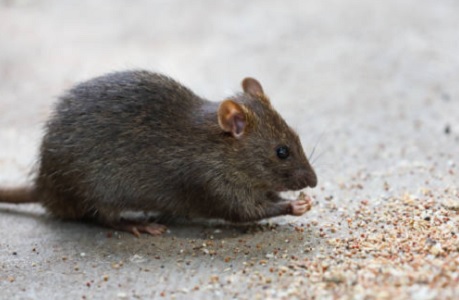
Although, while worshipping the deity, offerings are not directly made to the vehicle but it by default gets its due share from the offerings of the master. The combination of Ganesha and rat is perhaps one of the best examples of the deity controlling the negative energies as referred to in earlier paragraphs. In Rajasthan, the Karni Mata Temple is a dedicated place where rats are protected and revered for being Ganesha’s vehicle.
13. Such Other Animals:
The aforesaid animals and birds are widely loved, or even disliked for their negative attributes, by Hindus attaching divinity with them. But this love and symbolism is not restricted to them alone and there are a host of others too with similar attributes and linkages to Hindu gods and goddesses as vehicles, celestial being, and so on. For instance, owl is the vehicle of goddess Lakshmi representing wisdom; crocodile is vehicle of some river goddesses suggesting divinity; fish represents an incarnation of Vishnu for the salvage of life during the great deluge; antelope is vehicle of moon god; peacock is vehicle of Kartikeya (Skanda) representing grace, ferocity and aggression; parrot is vehicle of Kama, the god of love and lust; donkey is vehicle to Kaalratri (an incarnation of Shakti); vulture is vehicle of Ketu; crow is vehicle of Shani; and goat is vehicle to the solar deity Pushan, and is also linked to Agni.
The aforesaid description is fairly elaborate to make the intended point about the animal love in Hinduism and its symbolism but, for sure, not the comprehensive list and information about these animals and birds.
Some More Animal Facts & Essentials
Epilogue
The animal love and symbolic divinity attached to animal kingdom at large in Hinduism has not developed in few years or now; instead, it is a cumulative and sustained effect and dynamic product of the ingrained values and ethics in the Indian culture and religion (Sanatana Dharma) evolved thousand years ago. Even in the age of early civilization, when nearly all the cultural and ethnic tribes/groups evolved in different geographic entities were relatively close to nature and had similar belief in the natural deities, while most others believed in materialism and pursued the spirit of consumerism, the Vedic Hindus had pursued spiritualism with Brahman (God) as the ultimate reality and all other natural deities only as His manifestations, giving lesser weightage to materialism.
The later evolved Abrahamic religions accepted the presence of one God but they also escalated the belief that all other living beings and material stuff have been created by God or Allah for the consumption of the faithful (followers of the particular form of God). On the other hand, despite large scale globalization and onslaught of the aforesaid religions and communism (denying the existence of the divine), Hinduism has firmly believed and continued with the erstwhile noble concepts of Vasudhaiva Kutumbkam, Sarva Dharma Sambhava, Ahimsa Parmodharmah, and so on. It is this righteous approach and spirit genuinely and largely extended to the entire living world that many animals are recognized for their value and contribution to mankind with genuine love and symbolism.
Continued to Next Page
Illustration of Nandi (c) Niloufer Wadia
All photos (c) istock.com
06-Feb-2021
More by : Dr. Jaipal Singh